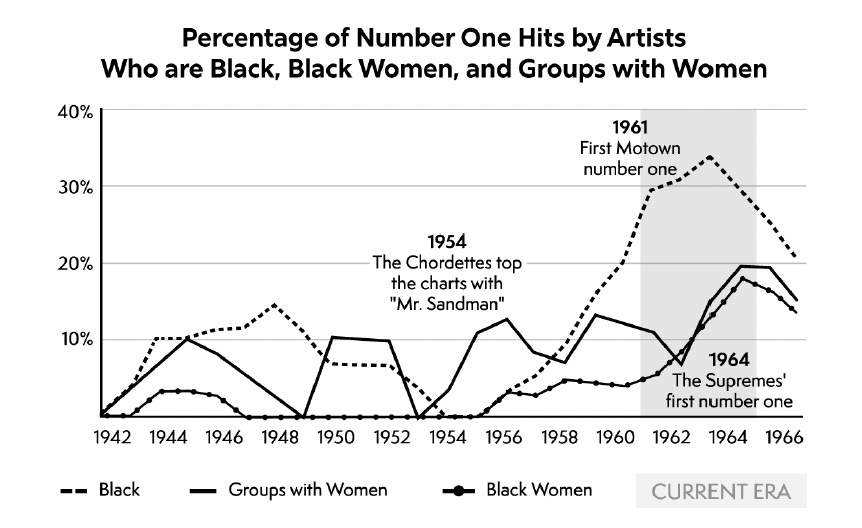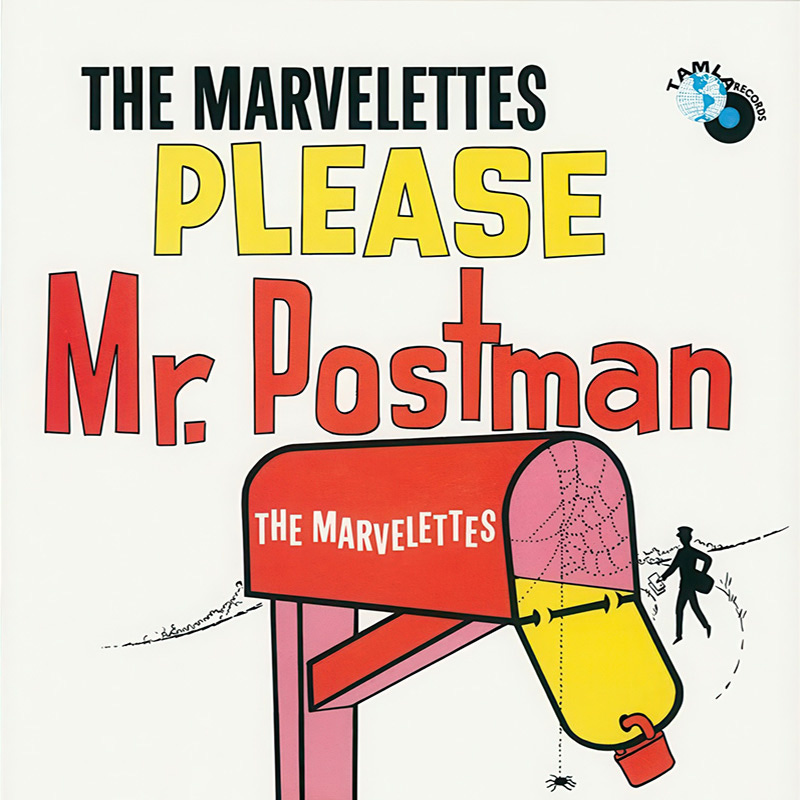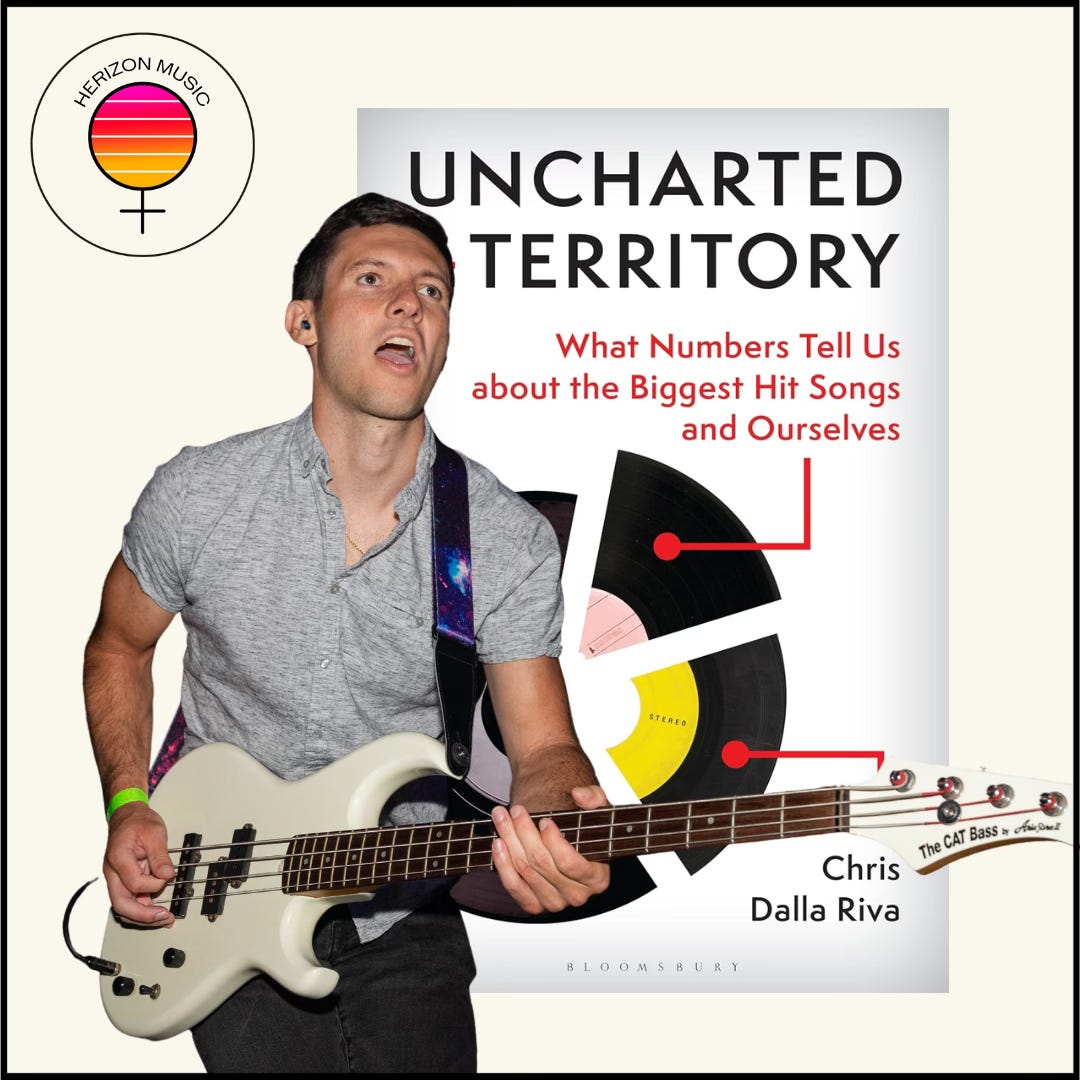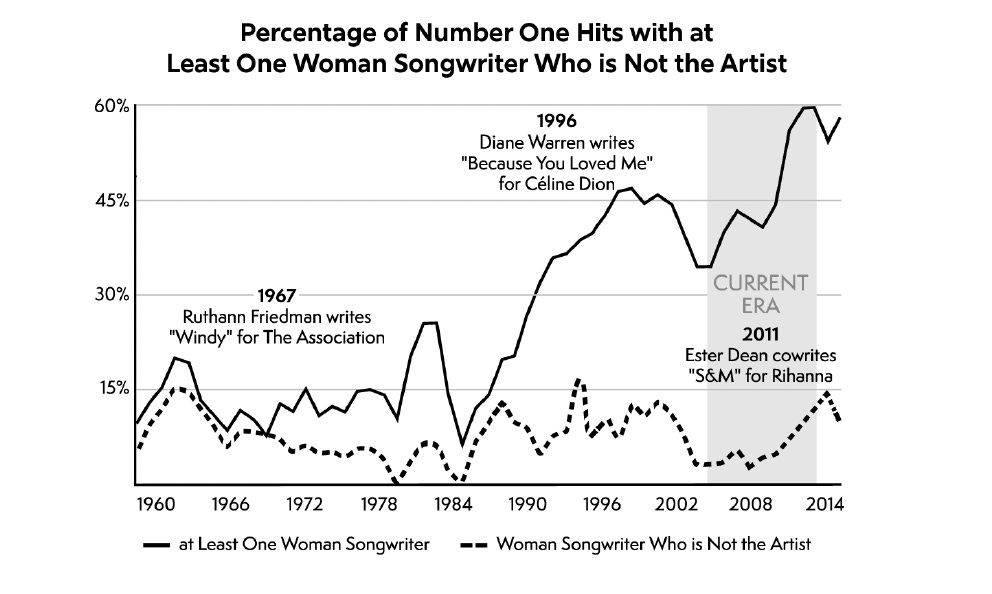Uncharted Territory: Book Preview and Sexism in Music By The Numbers
Author Chris Dalla Riva shares historical stats and insights about women in music
Thea Wood Productions, LLC is an Amazon Associate that earns from qualifying purchases at no extra cost to you.
Uncharted Territory: Book Preview and Sexism in Music By The Numbers
Chris Dalla Riva’s new book Uncharted Territory: What Numbers Tell Us about the Biggest Hit Songs and Ourselves (Bloomsbury Publishing) officially launches November 13, 2025. Music geeks are already pre-ordering the book and buying tickets for the book’s launch party in Hoboken, NJ. You can do both right here.
Subscribe to Herizon Music (Thea Wood)
Subscribe to Can’t Get Much Higher (Chris Dalla Riva)
Chris gave me a sneak peek at some chart trends for women in music. This infographic immediately caught my eye and served as the springboard for our short but info-packed Q&A. Let’s dive in…

THEA: Motown Records was the driving force behind Black artists achieving more #1 hits than any other time previous to the 1960s. Half of Motown’s chart-topping acts at the time were women. I don’t know of any other label today that can make that claim. What was Motown’s secret sauce for churning out #1 female acts?
CHRIS: I think part of it was the times and part of it was Motown itself. Leading up to the early 1960s, girl groups were having a huge moment. (Laura Flam and Emily Sieu Liebowitz detail this in their incredible book, But Will You Love Me Tomorrow? An Oral History of the ’60s Girl Groups.) Of course, vocal groups made up entirely of women were not new (e.g, The Andrews Sisters, The Chordettes), but this was a distinct phenomenon that melded close harmonies with rhythm and blues arrangements, as demonstrated by groups like The Bobbettes and The Chantels. Berry Gordy, the ever astute businessman, was very much following this trend.
At the same time, for an industry dominated by men, Motown had a large group of women making decisions from the outset. As I noted in my book, “[Gordy’s] four sisters and then-wife worked in notable roles at the company, and certain departments—like quality control, the department that selected which recordings to release—were headed by women.” I believe that the inclusion of women in decision-making roles helped foster women’s careers behind the microphone at Motown.
THEA: I’m also convinced that the label’s “Finishing School” expert Maxine Powell played a significant role in women’s success during the ‘60s. Television appearances were becoming a big boon for rising stars and having the right style, grooming, and communication skills made great first impressions on national broadcasts. MTV took it to another level when it launched. Do you see visual technological shifts contributing to women’s success when you look at the charts and trends?
CHRIS: I think you are onto something as Motown was especially cognizant of image. In fact, you’ll notice that some early Motown covers don’t even show the artists for fear that white Americans wouldn’t listen if they knew the artists were Black.
Image became more important with the proliferation of television. That importance only grew with the rise of MTV. I wouldn’t go so far as to claim that women only found chart success because image was more important. But we certainly see women pushing their art visually in the second half of the 20th century in ways that were not feasible in the first half.

THEA: What is a “topliner” and why do women get siloed into this role vs. other creative roles like music production or composition?
CHRIS: Historically, songwriting duos divided their labor between music and lyrics. Someone wrote the chords and the melody. Another person set that melody to words. This describes many duos in the early- to mid-20th century, including George Gershwin and Ira Gershwin, Carole King and Gerry Goffin, and Burt Bacharach and various lyricists.
This setup slowly broke down during the last few decades of the 20th century and eventually gave way to something called “track-and-hook.” Under this paradigm, you had a producer making chords and beats. Then a topliner would come in to do the vocal melody and lyrics. In the contemporary songwriting process, you are more likely to see women in toplining roles rather than producer roles. In fact, when I spoke to Bonnie McKee last year, she noted, “I’m producing now, but there is still an assumption that because I’m a woman that I’m only there to write a topline.”
In Chapter 11 of my book, I trace this to long-running stereotypes that deem women fit to interpret songs but not create them. Over the last few hundred years, “interpreting” usually meant singing. While toplining does involve composing, it is largely focused on vocal melodies. Thus, it makes sense that women are often siloed to the roles given how historically they were often siloed to singing roles.
THEA: In your book, you mention Kesha’s decade-long legal battles with producer Dr. Luke for alleged sexual assault and verbal abuse. Numbers vary depending on the source, but a 2018 survey by the Music Industry Research Association revealed that nearly 70% of women in the industry had experienced some form of sexual harassment; almost 50% do not report it and many who do say they are ignored or black listed. In your opinion, how can we make music-related careers safer for women?
Read “Tits Out: Kesha Waves Her Freedom Flag” article from Herizon Music.
CHRIS: Obviously, this issue is not exclusive to the music industry, so solving it in music likely requires larger systemic changes. Still, I feel like one of music’s issues is that it operates outside the strictures of normal 9-to-5 employment. Hours are not only irregular, but you learn your craft more in an apprentice model. Because the field was historically dominated by men, many of those mentor roles are still held by men. I think generational turnover is going to do much good for the industry as more women have slowly come into power. If you are a young woman, you will likely have the option to work with and learn from women going forward. I think having more women present in studios will lead to safer spaces.
Of course, that likely isn’t enough to correct all abuses. And I sadly don’t have a panacea to resolve everything. In the book, I am mostly highlighting an issue that I saw appear in the data rather than prescribing a solution. That felt a bit outside my area of expertise. But I think the last decade has shown that men can suffer consequences for their actions. My hope is that seeing those consequences inspires women to keep speaking up and teaches young men that that behavior is unacceptable. Clearly, there’s still a lot of work to be done.
Buy your copy of Uncharted Territory here.
Subscribe to Herizon Music (Thea Wood)
Subscribe to Can’t Get Much Higher (Chris Dalla Riva)
Thank you for joining our band of dreamers, rule breakers, and rockstars!
Until next time, it’s a wrap! 🎶
Thea Wood and Chris Dalla Riva
If you like podcasts, take a listen to Herizon Music’s Podcast!







Thanks for having me. This was a ton of fun!
Great information, as always. The work you share here is simply excellent and much needed.